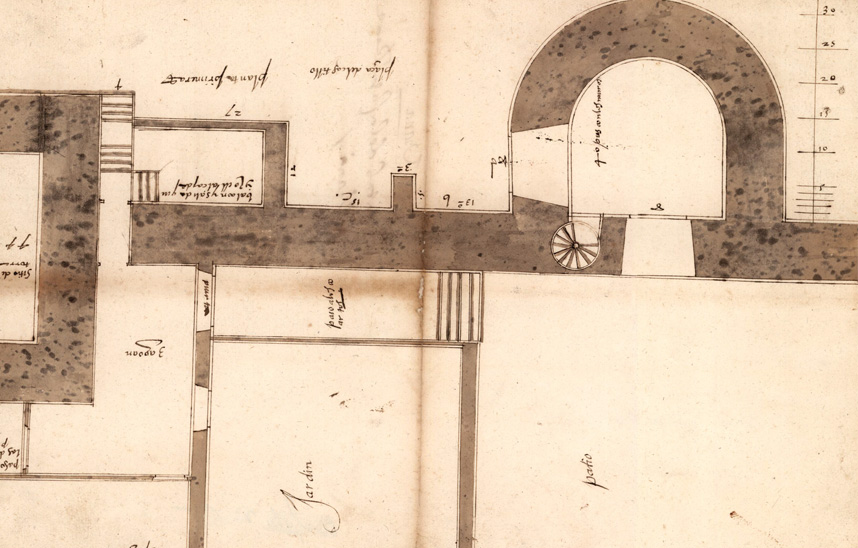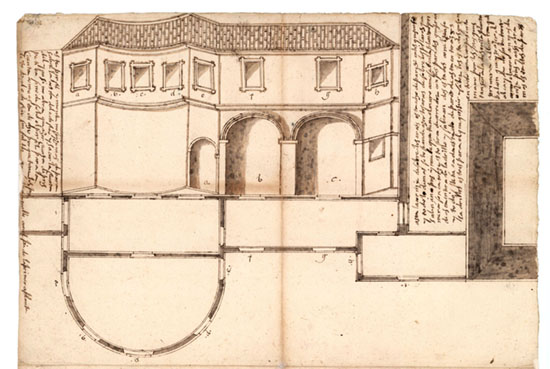The Augustinian Recollect Nuns in Viana and their ephemeral presence between 1676 and 1682.

FotoFototecadel file General de Navarra/Drawing of the plan of the royal house of Viana in 1593, with its towers, garden, courtyard and some rooms.
The foundational panorama of convents in Navarre during the 17th century is well known, including some cases such as that of the Conceptionists, which did not materialize in Corella. There is one case, that of the Augustinian Recollect Nuns in the city of Viana, which is much less known because its chronicle is found in a few pages of the second volume of the Esclarecido solar de las Recoletas, a work of Father Alonso de Villerino (Madrid, Bernardo de Villa-Diego, 1691). We base our reconstruction of the few years that the daughters of St. Augustine remained in Viana, between 1676 and 1682, on his text and on the judicial proceedings of some processes litigated in the courts of Navarre.
The origin of that foundation was in distant lands, concretely in the bequest of the knight from Extremadura, Fernando de Loaysa, who went to the Augustinian Sisters of Monterrey in Salamanca. The former bishop of that city, Don Gabriel Esparza, who occupied the mitre of Calahorra between 1670 and 1686, informed the nuns that the foundation was to be made in Viana, a city in Navarre belonging to his bishopric. The nuns from Salamanca accepted and the process of obtaining the necessary licenses from the city council and the Royal committee of Navarra began. In the acceptance of the Augustinian nuns, the argument of the aforementioned Gabriel Esparza had weighed heavily, according to which "although in Navarre all currency was gold and silver, the vellon passes in Viana, and that with less they could support more". The municipal acceptance did not take long and was positive, yielding the castle for convent, but with certain encumbrances such as not being able to bury in the church, which would be dedicated to the Magdalena, patron saint of the city. Among the knights who distinguished themselves for their support of project was Don Alonso de Lebrija.
Greater problems arose in the heart of the Royal committee, since some of its members saw the rent as short and the conditions of the town council as disadvantageous. Faced with the status, the nuns of Salamanca requested financial aid to their sisters of Pamplona. These were moving the spirits, but the oldest member of the committee had two daughters in the convent of Conceptionists of Tafalla, recently founded from Ágreda, and feared "that passing in Viana the fleece, the convent in which their daughters were would be delayed, entering in the Kingdom of no less austerity and of greater convenience by the saving of expenses". Father Villerino, with the freshness and knowledge of having been a very direct witness of the facts, affirms that "theNavarrese judges followed his opinion, but the Castilian judges, who were very disunited, united on that occasion and found themselves in that meeting of opinions three by three, because some were sick and others were absent. Of the three Navarrese, one was called Don Fermín Marichalar, a man of great wisdom, subtlety of wit and extreme dexterity, extremely fond of our Religion, who, desiring the foundation, without being in bad taste with the one who opposed it, told us that had it for him, and that he was a man of great wisdom, subtlety of wit and extreme dexterity, extremely fond of our Religion, told us that the committee had commanded him to go to an eye view outside of Pamplona, on which depended a lawsuit that was being litigated, and that since the Castilian lords were in favor of the nuns, he would leave immediately, and as soon as the sword was returned, he would go for the licence to committee. Thus the plan was executed, with which two Navarrese and three Castilian lords were found in the committee and the prosecutor Spanish also, to whom it fell to official document to oppose, if he had not been moved by piety, with which he quietly helped the good dispatch. The three Castilian gentlemen were the Regent of committee Don Alonso Escudero, Don Sebastián Montero de Espinosa and Don Bernardo de Medina Obregón". The latter was one of the most involved in the project and the granting of the permit because he had an Augustinian Recollect aunt in the convent of Valladolid. The three Castilian judges were natives of Valladolid, while the prosecutor, Don Francisco Zárate Ladrón de Guevara, was a native of Burgos.
With the licenses granted, on February 8, 1676, Mother Ana de San Nicolás, as prioress, María Bernarda de las Llagas, as suprior, Manuela Francisca de la presentation, as mistress of novices and sacristan, and a turner, left the convent of Salamanca as foundresses on February 8, 1676. In Viana, the Recollects of Pamplona had prepared a house for them that they owned at place, which was not very suitable because of the noise, the shouts of the youth and the internship of the ball. There the cloister was established on March 25, 1676. Soon after, they moved to another less capable house within the town of Viana, also owned by the nuns of Pamplona. With it "what they secured in quietness, they lost in comfort, because, although the house was not small, the nuns were not able to use it because the city on that side was in the form of a pineapple, so that one entered through a street on level ground in a room that corresponded to it, and from room to room one went down to another street leave well distant, so that it seemed to us when wewere goingdown thatwe wereburying ourselves. The walls, as the house had been inhabited by farmers, were sad and blackened by smoke...". At some points the community came to consider returning to Salamanca.

project palace on the site of the castle or royal house of Viana in 1593. Photo library of the file General of Navarra
Between September and October of that year of 1676, the nuns tried to acquire some houses and lots in order to enlarge the convent itself and to build a church, but it all ended in a failed project .
Some novices entered in Viana, among them also daughters of the city, two who came from Pamplona and a principal lady from Logroño. However, the problems came from the population and, above all, from the regular clergy and the councils of both parishes. Father Villerino speaks of mortal hatred and of a single priest of the city who supported them, a certain Don Martin, who because of his attitude had to face the scorn of the members of the chapter, as well as insults and opprobrium, publicly calling him a traitor to his state. The Augustinian chronicler calls the whole group of ecclesiastics "leopards who wanted to eat all those who showed affection for the nuns". In that iniquity we must not forget economic motivations due to the fear of losing income for different concepts.
To solve the problem of the house and the transfer to the dependencies of the fortification, the prioress of Pamplona, Mother Teresa de los Ángeles (Azpíroz Zunzarren), sister of Don José de Azpíroz, who was in the service of Cardinal Don Pascual de Aragón in Naples and later became a canon of the Cathedral of Toledo, intervened once again. The nun entered in 1637, died in 1692 and occupied the prelacy between 1665 and 1691. She maintained excellent relations in the Pamplona of the second half of the sixteenth century. For this last reason, she was approached by the nuns of Viana, since "in everything she did official document as mother with them in what happened to them". The prioress of Pamplona sent a person who is not identified in the chronicle to convince the municipal authorities to cede the castle without encumbrances, something that was achieved, achieving what seemed impossible, even several knights undertook to move different citizens to give the necessary wood for the adaptation works.
From Viana an information was made for the cession of that building and several witnesses testified, affirming that those factories showed to have had defensive function long ago, but that they no longer served for that purpose, pointing out that it was a plain house and it would be good for the nuns who lived in a very uncomfortable place, scarcely capable, without cemetery or well and without any ventilation.
In spite of everything, the iron civil service examination of the secular clergy of the city was increasing, some religious died and a reinforcement was sent from the convent of Ágreda. In the meantime, the offer of transferring the convent to the town of Miranda de Ebro in Burgos arrived, an offer that the nuns accepted. But, at this moment, the civil service examination came from the Navarrese city that went to the Royal committee to prevent it. The viceroy of Navarre at that time was Inigo de Velandia, Marquis of Tejada and Grand Prior of San Juan in Castile, a native of Miranda de Ebro, who favored the transfer. Father Villerino when narrating these facts affirms: "The enemy behaved in this departure, as in the death of Christ, making use of Pilate's wife to hinder it, because all that he had removed of charity from the hearts of Viana so that the Recollection did not make foot, entered them of sore vanity so that they would not let it leave to make the fruit to which the Lord directed it and they resisted to the order of the committee. Hardly had the news of their disobedience reached Pamplona, when a minister was dispatched from there to make way for the nuns. He arrived in Viana and the same night that he entered they mistreated him seriously, from which great expenses followed and especially to a gentleman who had favored the Recollection since he entered here".
The story continues with the entrance in Miranda de Ebro with numerous news and ends praising again the prioress of Pamplona as great protector of the community, outlining some gifts not only for this foundation but also for other convents such as Eibar or Murcia. The convent of Miranda de Ebro is today located in the district of Orón of the aforementioned city of Burgos, where it was moved in 1997, after being located since 1940 in a site provisional where the community had gone after the fire of the old monastery in the Civil War.
A couple of processes conserved in the section of Royal Courts of the file General of Navarre give account of the seizure "with force and violence" of four bundles with habits, sheets, scapulars, basquiñas and other belongings that were made to the nuns in the summer of 1682. By then, the bishop of Calahorra, Don Gabriel Esparza, had already authorized on April 8 of that year the transfer of the convent to Miranda de Ebro at the request of the prioress who had requested her licence, "representing the danger of falling from the castle where the nuns and convent are, according to the masters who have seen said castle, and wishing to leave it, the town of Miranda de Ebro has offered a hospice and church where they can build a room".
